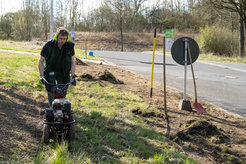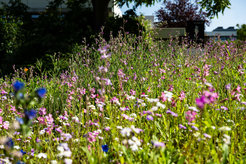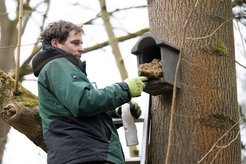
Biotope Blog
On this page we keep you updated on everything concerning the BioDiversum. How is the progess on the measures? What animals and plants are there to see? What else is going on? Find out here!
May 30, 2025
A feast for insects
Those who regularly pass by the Fassberg Campus may have noticed the newly sown wildflower meadow at the gate. This meadow and the additional 1.65 hectares in the BioDiversum are not only a treat to the eyes but also an important contribution to promoting insect diversity, according to a study by researchers at Wageningen University (Netherlands).

Wildflower meadows are a true paradise for insects. They offer a rich buffet for hoverflies, bumblebees, and numerous specialized wild bee species. The Dutch study shows that the seed mixture is crucial to a wildflower meadow’s attractiveness. Our regional seed mixtures, which contain over 30 plant species, have already proven effective, attracting more than 100 insect species in their first year.
However, maintaining such meadows is a demanding task. Once or twice a year, we mow them in sections with a bar mower to keep nutrient-loving grasses in check. Unfortunately, unfavorable weather conditions and the still nutrient-rich soil have allowed the grasses to regain the upper hand. We need to stay on the ball: Our gardeners are experimenting with customized seed mixtures and are now reseeding the areas step by step to find a long-term balance between grasses and wildflowers. Despite the dry weather this spring, the area at the gate is already showing promising progress.
You too can promote biodiversity in your garden. How about a colorful wildflower meadow buzzing with insects? The Royal Horticultural Society offers helpful tips on how to create your own meadow. With the NABU app “Insektensommer“ (in German), you can discover the diversity of insects in your garden. Join in and turn your garden into a real feast for insects!

April 29, 2025
BioDiversum meets City Nature Challenge

On April 28, twelve nature lovers met early in the morning in our BioDiversum for a bird-watching tour. Under the guidance of our colleague and hobby ornithologist Christian Dienemann, we explored the diverse bird life of our biotope, equipped with binoculars and pricked-up ears. We spotted over 20 different species, ranging from black redstarts and song thrushes to short-toed tree creepers.
The tour was part of the worldwide City Nature Challenge, which took place from April 25 to 28. It was the first time that Göttingen took part in the international “Bioblitz”. The aim of the challenge? To discover the biodiversity in the area and to document as many animal, plant, and fungal species as possible. With the help of modern apps, even beginners in ornithology could identify the species in the BioDiversum to later enter our observations into the global database iNaturalist.org – citizen science at its best!

A big thank you to everyone who participated! We hope that the City Nature Challenge has inspired you to become more aware of the natural world around you and to take an active role in protecting biodiversity. Take this opportunity to continue exploring your surroundings, learning new things, and sharing your knowledge with others.
Want to learn more about how you can get involved and connect with others to protect biodiversity in Göttingen? Then have a look at the new platform fokus-vielfalt.de (in German only).
April 10, 2025
A wooden paradise
Spring is coming to the BioDiversum and the first shrubs are sprouting. But what should we do with the clippings from the last few months? Our gardeners had a creative idea: They used the leftover branches to create a deadwood hedge. It now adorns the forest below the canteen and will hopefully soon become a biodiversity hotspot.

Many gardens are dominated by pristine greenery, but this order comes at a cost: Natural hiding places and food sources are dwindling. Our deadwood hedge addresses this problem by being deliberately messy. Deadwood hedges are loosely stacked branches and twigs held in place by sturdy wooden posts. This seemingly “waste” material transforms over time into a vibrant ecosystem. Deadwood is not “dead” wood, but a haven for native wildlife. The cavities between the branches create microhabitats that are particularly rich in species. Thousands of species, including insects like the violet carpenter bee, birds like the wren, hedgehogs, and even lizards, find shelter and food here – a real all-inclusive habitat!
With simple means, you can create a biodiverse habitat that serves as a natural privacy screen at the same time. Have you not yet got rid of your clippings? Try creating your own deadwood hedge in the garden – the sunnier the better! For more information on creating your own, visit the RSPB website.
March 18, 2025
How do insects hibernate?
During the cold season, we only see a few insects in our otherwise colorful biotope. But where have they gone instead? The answer varies from animal to animal.
Adaptation artist

The admiral (Vanessa atalanta) originally belonged to the migratory butterflies and traveled long distances to the southern Mediterranean, North Africa, or the western Sahara in winter. In the meantime, however, the butterfly has become a true adaptation artist. While most species can only overwinter in a particular stage of development – for example, as a caterpillar – the admiral is more flexible. Some of them continue to fly to warmer regions, but more and more admirals are now braving the cold. As a butterfly, it likes to seek shelter in dense ivy plants where evergreen leaves protect it from frost and moisture. The caterpillars of the admiral can also survive a mild and less frosty winter before the first colorful butterflies hatch in April and flutter through our BioDiversum again.

Stiff from the cold
Dragonflies are known for their breathtaking flight technique, with which they skillfully maneuver over our biotope pond in summer. But with the onset of winter, they disappear almost completely. Except for the winter dragonfly, the adults of other species die in late fall. To ensure that the fast predators can go hunting at our pond again next year, they lay their eggs near the water on plants and grasses beforehand. The eggs and larvae then go into hibernation and survive the cold season until the next generation of dragonflies hatches in spring.
Lone survivor

Wild bees are frequent and welcome guests in our biotope, as they essentially contribute to the pollination of our plants. Unlike honey bees, wild bees are usually solitary and do not have a hive to protect them from the cold temperatures in winter. Instead, wild bees rely on other hibernation strategies, differing from species to species. For example, the sand bees (genus Andrena), which are frequently found in our biotope, lay their offspring in nests in the ground. The female builds a separate brood cell for each egg and leaves sufficient food supplies for her larvae. These pupate in a cocoon in which they spend the entire winter. In spring, the young sand bees hatch and leave their ground nest. Other wild bee species use alternative hibernation strategies: They seek shelter in hollow plant stems or tree holes and endure there until the cold season is over.
Now that spring is just around the corner, we are looking forward to seeing many different insects in our biotope again soon.
February 28, 2025
A home for our birds
Who of you has been counting during the “Hour of Winter Birds”? In this NABU initiative, citizens like you and me spend an hour on a weekend in January counting birds in our gardens. Unfortunately, this year's results show an alarming decline: In Lower Saxony alone, the ten most common songbird species were spotted one-fifth less often.

In light of these figures, our commitment is more important than ever. In our BioDiversum, we have implemented several measures for our feathered friends: a well-frequented bird feeding station throughout the year, a pond and insect-rich wildflower meadows as food sources, as well as shrubs as hiding and breeding places.
This month, it was time for the annual “spring cleaning” of our nest boxes: Our team of gardeners removed old nesting material to protect the new tenants from parasites and predators. Our nearly 100 nest boxes are almost fully booked each year – and are also very popular with the garden dormice for hibernation. We plan to add more "housing" for birds in the future.
Only the half-caves for robins, wrens, and blackstarts have been rejected so far – perhaps the location is not yet right. By repositioning the boxes, we hope to make the unused homes more attractive in the future: sheltered from the wind and with unobstructed access for the expectant parents.
Due to the loss of natural habitats, feeding stations, nest boxes, and structurally rich areas are a true gift to our birdlife. So let us work together to ensure that our gardens and biotopes remain safe havens for birds!
Spring cleaning in the BioDiversum
January 31, 2025
Nature conservation – learning step by step
Although it is only January, our biotope is already waking up from hibernation. The bird feeding station is a hive of activity, the first shrubs are flowering, and our gardeners are eagerly at work.
Have you ever visited our BioDiversum? Wildflower meadows, shrubs, open ground, or clearance cairns: Our biotope is a colorful mosaic of structures. In principle, the more diverse the habitat, the greater the biodiversity – as shown in a study conducted by researchers at the University of Göttingen in 2020. Diversity allows different species to find their own niche.
However, the study also shows that ecosystems are complex. Each of them is unique, and sometimes measures intended to preserve or improve the habitat do not work as planned – also in our biotope. In the end, nature conservation means a lot of trial and error and learning from mistakes.
In any case, we will continue to work on promoting and protecting biodiversity around the institute – and in Germany.
In the coming months, we will take you on a look back and ahead: What is going well in the BioDiversum? Where are we still experimenting? Where do we go from here?










